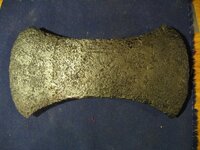Valley Ranger
Silver Member
- Mar 24, 2011
- 2,515
- 1,368
- 🏆 Honorable Mentions:
- 1
- Detector(s) used
- Minelab Equinox 800, Garrett AT Pro (2), Makro Racer 2, Garrett AT Pinpointer (2)
- Primary Interest:
- Relic Hunting
Haven't found a whole lot of interest lately. I'm working on permission for a couple of new spots while waiting for DIV to get there. One of the area farms I keep going back to until then (and where I found a nice Confederate Block A button last December) keeps giving up ax heads. I've found 3 there. Below is a photo of my first double bitted ax head. It overloaded my T2SE and I almost didn't dig it, assuming it was a plow piece or some other iron junk. I don't have a before photo (though I'm working on a video that will show it before it was restored), but this is what it looks like after being restored. As you can tell from the pitting, it was very rusty when first dug. I've had some success with electrolysis but I read about another process a couple of weeks ago that works well on rusty iron - soaking in apple cider vinegar. That is what I did on this piece. It soaked for about a week and I changed out the vinegar twice. It worked just as well as electrolysis. Then I spent about an hour on it using a wire brush, a wire brush bit in a drill, and a wire brush on a Dremel. I then "cooked" it in the oven at 200 degrees for an hour to remove any remaining moisture and, while it was still hot, applied a healthy coat of Briwax to seal it and give it a gentle luster. The inside where the handle goes was impossible to get all the rust out, so I treated it with Rust Converter. It works well, but turns iron black. I'm going to get a hickory handle for it and proudly display this piece in my office. But I have a question, is there any way to date these ax heads by their shape? Thanks for any help.
Amazon Forum Fav 👍
Attachments
Upvote
0










